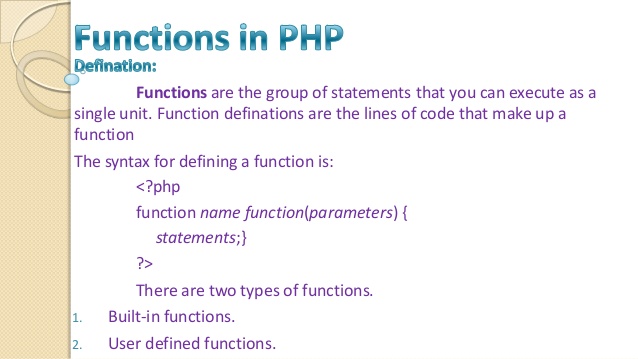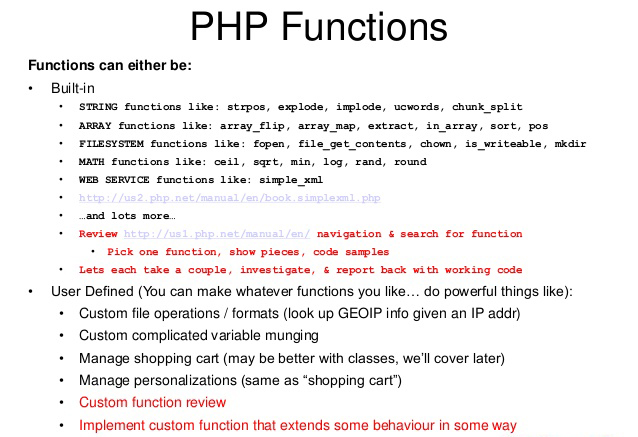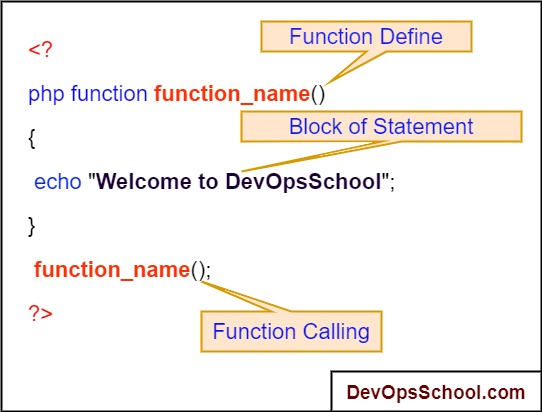
What is Functions?

A function is a section of code in a programme that is written to execute a particular operation. For a deeper understanding of how functions perform, we should compare them to workers in a real-world workplace. Let’s say the manager assigns his employee the task of calculating the annual budget. So, how will this procedure end? The employee would obtain knowledge about the statistics from his superior, conduct estimates, measure the budget, and present the results to his superior. In a similar way, functions perform. They take data as a parameter, run a block of statements or perform operations on it, and then return the result.

How many Types of Functions in PHP?
There are Two Types of Functions :-

- User Defined Functions:- When a developer or programmer has to run their own logic, they use these features. This functions are described with the keyword function, and a series of statements will be written within the function to execute it when a function call is made. The function can be called by simply typing functionname() into the address bar, and the function will be executed.
- Built-in functions:- These functions provide us with library functions that are already built-in. These features are included in the PHP installation kit, making the language more efficient and useful. To use the function’s properties, we simply need to call it if we need to get the desired result. Date, Numeric, String, and other built-in functions are all used in PHP.
- String Functions: In PHP, these features have a built-in functionality for working with strings. strpos(), strncmp(), strrev(), and strlen() are several of the string functions included in PHP (),
- Date Function: The format is a UNIX date and time, which is a human-readable format, and these functions are predefined elements in PHP.
- Numeric Functions: These functions have their own predefined logic that is used for numeric operations which is given by PHP. It will either return a Boolean or a numeric value as a result. Is number(), number format(), round(), and other numeric functions are among them.
Why we should Use Functions in PHP?
- Reusability:- A feature is used in any programming language to minimize the number of lines of code that must be written several times. This would save the developer or programmer time and effort. If a piece of code has to be used in many places, we can put it in a feature and call it whenever and wherever it’s needed. This can be accomplished by calling the functions from inside the same package or from other programmes.
- Easier Error Detection:- Since the code is not written in a single block but rather in functions, any errors that exist can be quickly and easily identified and corrected.
- Easily Maintained:- As functions are used in the program, so if any function or any lines of code needs to be changed, we can change it easily in the function and the change will be reflected. Hence, it is easy to maintain anywhere.
How to create functions in PHP?

A function is a set of statements that can be found over and over again in a programmer. When a function is called in a program, it is just implemented. When designing a user identified feature, there are a few things to bear in mind.
- A feature is any word that ends with an open and closed parenthesis.
- The keyword function is often used to start a function name.
- To invoke a command, simply type its name followed by the parenthesis.
- A number cannot be the first character in a feature word. It may begin with a letter or an underscore.
- The case of a feature name is unimportant.
Syntax:-
Users can describe their own functions in PHP. A user-defined function declaration begins with the keyword function and ends with the { … } braces, which include all of the code.
Example:-
Output:-

Code:-
We’ll make a hello() function in the example below. “Hello world!” is the contribution of the function. Write the name of the feature followed by brackets (); to call it.
Function with Parameters or Arguments:-
Parameters are the details or variables contained within the function’s parenthesis. These are used to store the values that can be executed at runtime. A user can enter as many parameters as he desires, separated by the comma(,) operator. At runtime, these parameters are used to accept inputs. Arguments are used for exchanging numbers, such as during a function call. A parameter is used to carry arguments passed to a function. An argument is a value passed to a function. Both parameter and statement have the same meaning in layman’s terms. It’s important to remember that each parameter must be accompanied by its corresponding argument.
Example:-
Output:-

Setting Default Values for Function parameter
We can set default argument values for function parameters in PHP. If no argument is passed for a parameter with a default value, PHP will use the parameter’s default defined value in the function call.
Output:-

The parameter $num in the preceding example has a default value of 12; if no value is passed for this parameter in a function call, the default value 12 will be used. Also, since the parameter $str has no default value, it is needed.
Functions with return values:-
Functions can also return values to the programme section from which they were invoked. The return keyword is used to return the value to the programme section from which it was named. Every sort of value, including arrays and objects, may be returned. The return statement also signals the end of the function, halts execution, and returns the value.
Example:-
Output:-

Parameter passing to Functions
We can move an argument to a function in one of two ways in PHP.
- Pass by Value:– The value of an argument is modified within a function by moving by value, but the original value outside the function remains unchanged. This implies that a statement is transferred that is a repeat of the original value.
- Pass by Reference:– The original value is transferred as statements are passed by proxy. As a result, the initial value is modified. We simply transfer the address of the value, where it is stored, using the ampersand sign in pass by reference (&).
Example:
Output:-

Conclusion:-
In this article, we looked at the different forms of PHP functions as well as their characteristics such as What is Functions, How many Types of Functions in PHP, Why we should Use Functions in PHP, How to create functions in PHP.. Developers and programmers like to write code using these two features because it eliminates the need to rewrite it and makes it easier to evaluate because it is written depending on the job at hand.
- Degree Pursuit: Navigating the Path to Educational Excellence - July 4, 2024
- Why Is Studying English Important in a Business Environment? - July 4, 2024
- Top 10 Data Science Skills You Need in 2024 - July 3, 2024

